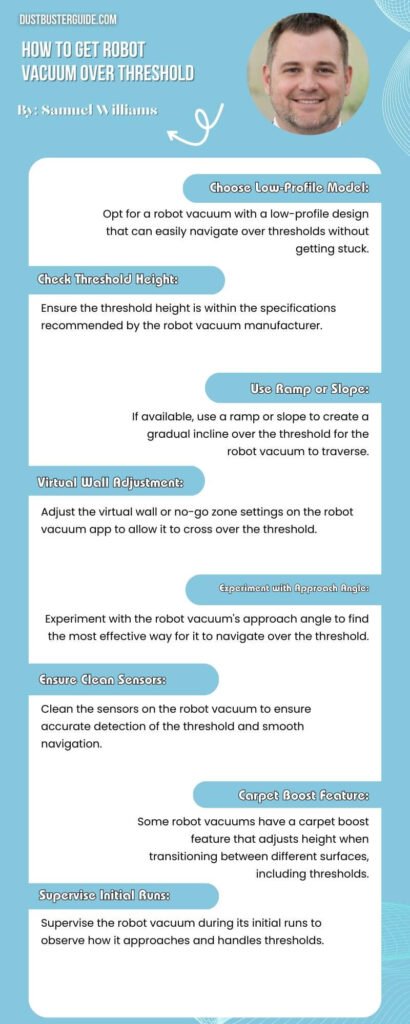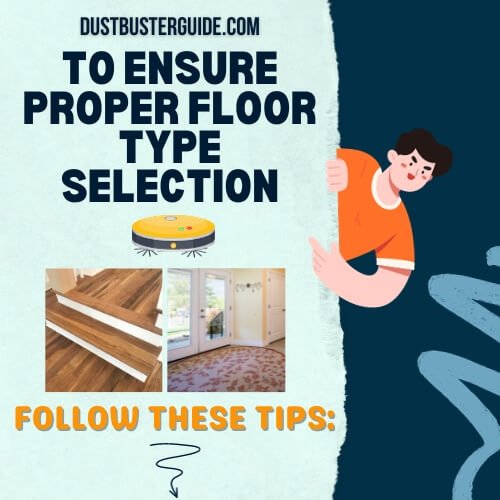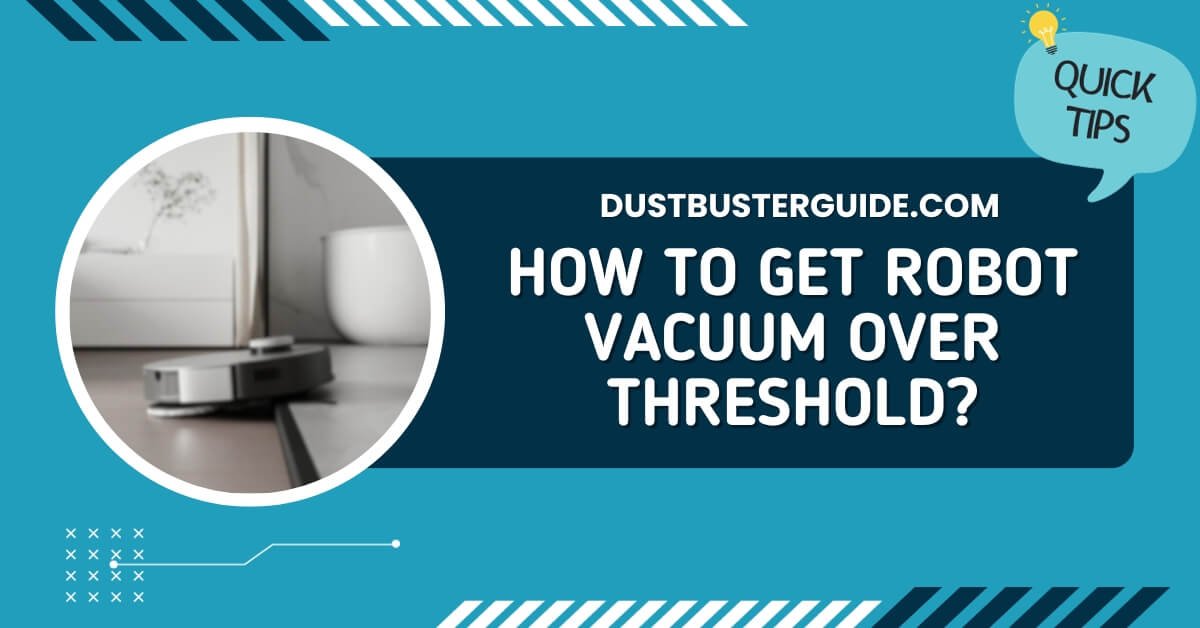The mobility ballet of your robot vacuum encounters an elevation challenge: how to get robot vacuum over threshold? It’s an exploration into assisting your cleaning companion in overcoming obstacles for comprehensive cleaning.
Picture this: your diligent robot vacuum approaching a threshold, and the question arises. In just a couple of lines, the answer maneuvers in like an elevation revelation: Elevate the wheels slightly or use ramps to help your robot vacuum gracefully cross thresholds without hindrance. But before you assume it’s a complex maneuver, join us on this exploration.
We’ll guide you through the simple steps to ensure your robot vacuum smoothly navigates over thresholds.
Understanding The Challenges Of Thresholds For Robot Vacuums
Are you struggling to figure out why your robot vacuum can’t seem to get over thresholds? Let’s dive into the challenges that robot vacuums face when it comes to tackling thresholds and how you can help them overcome these obstacles.
One of the main challenges robot vacuums encounter when trying to cross thresholds is their height and design. Most robot vacuums are relatively low to the ground, which can make it difficult for them to navigate over taller thresholds. The wheels of the vacuum may get stuck or lose traction when trying to climb over a threshold that is too high.
Additionally, some robot vacuums have a round shape, which can make it challenging for them to maintain stability while navigating over uneven surfaces like thresholds.
Another challenge is the type of material the threshold is made of. Some robot vacuums may struggle to grip or gain traction on certain types of thresholds, especially those made of slippery materials like polished wood or tile.
The wheels of the vacuum may spin or slip, preventing it from successfully crossing the threshold. It’s important to consider the surface material of your thresholds when choosing a robot vacuum, as some models may have better traction on specific types of surfaces.
To help your robot vacuum overcome these challenges, there are a few things you can do. First, make sure to measure the height of your thresholds and compare them to the clearance height of the robot vacuum you’re considering. Look for models with a higher clearance if you have taller thresholds in your home.
Additionally, consider investing in a robot vacuum with a more stable design, such as one with a wider base or larger wheels. This can improve the vacuum’s ability to navigate over thresholds and maintain balance.
Lastly, if you have thresholds made of slippery materials, you can try placing non-slip mats or adhesive strips on them to provide additional traction for the robot vacuum.
By understanding the challenges robot vacuums face when it comes to thresholds and taking the necessary steps to overcome them, you can ensure that your robot vacuum effectively cleans all areas of your home, including those with thresholds.

How To Get Robot Vacuum Over Threshold Using Threshold Ramps
Using threshold ramps can help you smoothly transition your robot vacuum across different surfaces. These ramps are specifically designed to bridge the gap between two surfaces, such as a hardwood floor and a carpeted area, making it easier for the vacuum to move from one surface to another without getting stuck. By using a threshold ramp, you can ensure that your robot vacuum can effortlessly navigate through your home, keeping your floors clean and saving you time and effort.
To better understand the benefits of using threshold ramps, let’s take a look at a comparison table below:
| Challenge | Without Threshold Ramps | With Threshold Ramps |
| Stuck Vacuums | Robot vacuums often get stuck at thresholds, unable to transition smoothly. | Threshold ramps provide a gradual incline, allowing robot vacuums to move seamlessly across different surfaces. |
| Floor Damage | Continuous bumping against thresholds can cause scratches and damage to the robot vacuum and the floor. | Threshold ramps prevent any potential damage by eliminating the need for the vacuum to forcefully cross thresholds. |
| Noise | Struggling to cross thresholds can result in loud noises and vibrations. | Threshold ramps reduce noise and vibrations, providing a quieter cleaning experience. |
| Efficiency | Without ramps, the vacuum may spend more time trying to navigate thresholds, reducing overall cleaning efficiency. | Threshold ramps ensure efficient cleaning by enabling uninterrupted movement throughout your home. |
As you can see, using threshold ramps can solve many challenges that robot vacuums face when transitioning across different surfaces. These ramps not only make the cleaning process easier for your vacuum but also protect your floors from any potential damage. So, if you want to optimize your robot vacuum’s performance and ensure a hassle-free cleaning experience, investing in threshold ramps is definitely worth considering.
How To Adjust Settings For Optimal Performance
To optimize your robot vacuum’s performance and ensure a hassle-free cleaning experience, it’s important to make adjustments to the settings for optimal performance. By customizing the settings according to your specific needs, you can overcome the challenges of getting your robot vacuum over thresholds and other obstacles in your home.
Firstly, check if your robot vacuum has a height adjustment feature. This will allow you to raise or lower the vacuum’s cleaning head to accommodate different thresholds. If your vacuum has this feature, simply adjust it to the appropriate height for your thresholds. This will ensure that the vacuum can easily glide over the thresholds without getting stuck or causing any damage.
Additionally, some robot vacuums offer different cleaning modes or power settings. Experiment with these settings to find the one that works best for your home. For example, if you have thick carpets or high-pile rugs, you may need to activate a more powerful cleaning mode to ensure deep cleaning.
On the other hand, if you have delicate floor surfaces, you might want to switch to a gentler mode to prevent any damage. By adjusting these settings, you can ensure that your robot vacuum is equipped to handle the challenges of getting over thresholds while still effectively cleaning your floors.
Adjusting the settings of your robot vacuum is crucial for optimal performance, especially when it comes to getting over thresholds. By utilizing features such as height adjustment and different cleaning modes, you can customize your vacuum settings to meet your specific needs.
These adjustments will not only help your robot vacuum smoothly navigate over thresholds but also ensure thorough cleaning of your floors.
So don’t forget to take some time to explore and experiment with the settings of your robot vacuum to achieve the best results.
How To Ensure Proper Floor Type Selection For Robot Vacuum

Proper floor type selection is essential for ensuring the optimal performance of your robot vacuum. Different floor types require different cleaning techniques, and selecting the right floor type setting on your robot vacuum can make a significant difference in its cleaning effectiveness.
Whether you have hardwood floors, carpets, or a combination of both, here are some tips to ensure that your robot vacuum can easily navigate and clean your floors.
For hardwood floors, it’s important to choose a floor-type setting that avoids excessive suction power. High suction power can cause the robot vacuum to stick to the floor, making it difficult for it to move around. Additionally, it can potentially damage the delicate surface of your hardwood floors. Opt for a lower suction power setting that is gentle yet effective in picking up dirt and debris.
On the other hand, if you have carpets in your home, you’ll want to select a floor type setting that maximizes suction power. Carpets tend to trap more dirt and dust, so a higher suction power will ensure a thorough cleaning. Most robot vacuums have a specific setting for carpets or a ‘carpet boost’ feature that automatically increases suction when detecting carpeted surfaces. This allows the vacuum to dig deep into the fibers and remove embedded dirt.
If you have a combination of hardwood floors and carpets, look for a robot vacuum that offers customizable floor-type settings. This way, you can easily switch between settings depending on the area of your home the robot vacuum is cleaning. Some advanced robot vacuums even have sensors that can automatically detect the floor type and adjust their cleaning settings accordingly.
By ensuring proper floor type selection, you can optimize the cleaning performance of your robot vacuum. Whether you have hardwood floors, carpets, or a mix of both, choosing the right floor type setting will help your robot vacuum navigate and clean your floors effectively. So, take a moment to familiarize yourself with the floor type options on your robot vacuum and make adjustments accordingly. Your floors will thank you for it!
What Are The Best Practices For Creating A Clear Path For Your Robot Vacuum To Clean Around
When clearing obstacles and clutter around thresholds, it’s important to create a clear path for your robot vacuum to navigate through.
Thresholds can pose a challenge for robot vacuums as they can be higher or wider than the vacuum’s clearance height. To ensure the robot vacuum can easily cross over thresholds, here are some tips to follow.
- Firstly, remove any loose objects or clutter that may be present around the threshold area. This includes items such as shoes, toys, or any other objects that could potentially obstruct the vacuum’s path. By clearing the area, you provide a clear and obstacle-free zone for the robot vacuum to move through.
- Next, check the height of the threshold. If the threshold is higher than the clearance height of your robot vacuum, you may need to make some adjustments. One option is to use threshold ramps or transition strips that can bridge the gap between the floor surfaces. These ramps can provide a smooth incline for the robot vacuum to easily cross over the threshold without getting stuck.
- Additionally, you can also try using magnetic strips or boundary markers that come with some robot vacuum models. These strips can be placed on the floor to create a virtual barrier that the robot vacuum will not cross. By strategically placing these strips around the threshold area, you can guide the robot vacuum to avoid attempting to cross over thresholds that it may struggle with.
By following these tips and creating a clear path for your robot vacuum, you can ensure that it can easily navigate over thresholds and effectively clean your home. Remember to regularly check for any obstacles or clutter that may have accumulated around thresholds to maintain the optimal performance of your robot vacuum.
Pros And Cons Of Clearing Obstacles And Clutter Around Thresholds
Regular Maintenance And Cleaning Of Robot Vacuum
Regular maintenance and cleaning of your robot vacuum is essential to keep it running smoothly and effectively. By following a few simple steps, you can ensure that your robot vacuum stays in top shape and can efficiently navigate over thresholds in your home.
Firstly, it’s important to regularly empty the dustbin of your robot vacuum. As the vacuum collects dirt, dust, and debris from your floors, the dustbin can quickly fill up. If the dustbin becomes too full, it can hinder the performance of the robot vacuum and prevent it from effectively cleaning your home.
To prevent this, make it a habit to empty the dustbin after each cleaning session or whenever it reaches its maximum capacity.
In addition to emptying the dustbin, it’s also important to clean the brushes and sensors of your robot vacuum. Over time, these components can become clogged with hair, strings, and other debris, which can affect the vacuum’s ability to effectively clean and navigate over thresholds.
To clean the brushes, remove them from the vacuum and use a pair of scissors or a brush to remove any tangled hair or debris. For the sensors, gently wipe them with a clean, dry cloth to ensure that they’re free from any dirt or dust.
Regular maintenance and cleaning of your robot vacuum is crucial for its optimal performance. By regularly emptying the dustbin and cleaning the brushes and sensors, you can ensure that your robot vacuum is able to effectively clean your home and navigate over thresholds with ease. So, make it a habit to take care of your robot vacuum, and it’ll continue to keep your floors clean and free from debris.
How To Troubleshoot The Common Issues with Threshold Navigation
Now that you know how to regularly maintain and clean your robot vacuum, let’s address some common issues you may encounter with its threshold navigation. Troubleshooting these problems can help ensure that your robot vacuum efficiently moves over thresholds without any hiccups.
So, if you’re facing difficulties with your robot vacuum navigating door thresholds or other raised surfaces, keep reading for some helpful tips.
One common issue is when the robot vacuum gets stuck on the threshold and struggles to move forward. This can be caused by a variety of reasons, such as the height of the threshold being too high for the robot to handle or the wheels not gripping the surface properly.
To overcome this problem, you can try adjusting the height of the robot vacuum or using a threshold ramp to create a smoother transition. Additionally, make sure the wheels are clean and free from any debris that may hinder their movement.
Another issue you might encounter is the robot vacuum hesitating or changing direction when it reaches a threshold. This can be frustrating, as it disrupts the cleaning process and may result in missed spots.
One possible solution is to check the sensors on your robot vacuum. Sometimes, these sensors can be triggered by dark or reflective surfaces, causing the robot to perceive the threshold as an obstacle. To address this, you can try placing a contrasting mat or tape on the threshold to make it more visible to the sensors. Additionally, ensure that the sensors are clean and free from any dirt or dust that might interfere with their accuracy.
By troubleshooting these common issues with threshold navigation, you can optimize the performance of your robot vacuum and ensure it effectively cleans your home, effortlessly moving over thresholds without any trouble.
Can Roomba Go From Hardwood To Carpet
Based on the search results, Roomba robot vacuums can go from hardwood to carpet without any issues. The vacuums are designed to automatically adjust to different floor types, including wood, carpet, tile, vinyl, and laminate.
The Roomba’s intelligent navigation system allows it to move between these surfaces without getting stuck, and its sensors enable it to detect floor transitions and adjust its cleaning method accordingly.
Additionally, high-end Roomba models are known for their efficiency in cleaning carpets, including thick ones, due to their combination of brushes and suction power.
Therefore, based on user experiences and product features, Roomba robot vacuums are well-suited for cleaning both hardwood floors and carpets, making them a versatile choice for various floor types.
Conclusion
So now you know how to get robot vacuum over threshold. Ensuring your robot vacuum can navigate thresholds effectively involves understanding challenges and implementing strategies. Threshold ramps offer smooth transitions while adjusting settings like suction power is essential for optimal performance. Selecting the right floor type setting and clearing obstacles around thresholds are key. Regular maintenance keeps your vacuum in top shape. If issues arise, troubleshooting steps are available. By addressing these aspects, your robot vacuum can navigate thresholds seamlessly, providing efficient cleaning for your home.
FAQs
How do thresholds affect the performance of robot vacuums?
Thresholds can significantly impact the performance of robot vacuums. They can cause the vacuum to get stuck or struggle to transition from one surface to another. Understanding how thresholds affect your robot vacuum can help you find solutions to overcome these challenges.
What are threshold ramps and how do they help with smooth transitions?
Threshold ramps are useful tools that aid in smooth transitions for robot vacuums. They are designed to bridge the gap between different flooring surfaces, making it easier for the vacuum to move over thresholds and other obstacles.
Can robot vacuums be adjusted to optimize their performance over thresholds?
Yes, robot vacuums can be adjusted to optimize their performance over thresholds. By adjusting the height settings, increasing suction power, or using virtual walls, you can ensure that your robot vacuum easily crosses thresholds and effectively cleans your floors.
What are some common issues with threshold navigation that may require troubleshooting?
Common issues with threshold navigation that may require troubleshooting include the robot vacuum getting stuck, being unable to climb over high thresholds, or getting caught on uneven surfaces.
Can Shark IQ go over thresholds?
The Shark IQ Robot Vacuum is designed with Smart Sensor Navigation, which prevents it from falling down stairs. However, it’s essential to ensure that the vacuum can clear the height difference without falling or getting stuck.
Can robot vacuums go over the steps?
Some robot vacuums can go over steps, but it depends on the specific model and its clearance height. For example, the Shark IQ Robot Vacuum is designed to navigate around stairs and other obstacles.
External Resources
- Lessons Learned From Robotic Vacuum Cleaners Entering In The Home Ecosystem – ResearchGate
- Dyson Launched The World’s Most Powerful Robot Vacuum In This Week’s Tech Roundup – Hypebeast
- Living With A Vacuum Cleaning Robot – ResearchGate
- Selection Of Vacuum Cleaner With Technique For Order Preference By Similarity To Ideal Solution Method Based Upon Multi-Criteriadecision-Making Theory – SAGE Publications

